Feasibility of applying the lower cut-off frequency for the density radial coverage extension in EAST reflectometry measurement
Jia HUANG (黃佳), Xiang HAN (韓翔), Kaixuan YE (葉凱萱),Tao ZHANG (張濤), Fei WEN (文斐), Mingfu WU (吳茗甫)Kangning GENG(耿康寧),Gongshun LI(李恭順),Fubin ZHONG(鐘富彬),Yukai LIU (劉煜鍇), Haoming XIANG (向皓明), Shuqi YANG (楊書琪),Shoubiao ZHANG (張壽彪), Xiang GAO (高翔), Ge ZHUANG (莊革) and the EAST Team
1 University of Science and Technology of China, Hefei 230026, People's Republic of China
2 Institute of Plasma Physics, Chinese Academy of Sciences, Hefei 230031, People's Republic of China
3 Advanced Energy Research Center,Shenzhen University,Shenzhen 518060,People's Republic of China
4 Key Laboratory of Optoelectronic Devices and Systems of Ministry of Education and Guangdong Province, College of Optoelectronic Engineering, Shenzhen University, Shenzhen 518060, People's Republic of China
Abstract The extraordinary mode (X-mode) lower cut-off frequency is proposed for use in the reflectometry diagnostic on ITER for the electron density profile measurement,which is a trade-off between extreme plasma parameters and the accessible probing frequency.In contemporary experiments,the lower cutoff frequency can be identified at the probing frequency below the electron cyclotron frequency(fce)under certain plasma conditions.We provide here,for the first time,the experimental validation of the use of the lower cut-off frequency for the density profiles via the reflectometry measurement on EAST.The corresponding group delay of the lower cut-off frequency evolves continuously with the upper one, revealing a reasonable radial coverage extension of reflectometry measurement toward the plasma core.It is concluded that the lower cut-off frequency can be used as a supplement to the upper one in the density profile inversion process,which is of particular interest in the high magnetic field and/or density discharge to extend the radial coverage of reflectometry measurement.
Keywords: X-mode reflectometry, density profile, EAST, lower cut-off frequency
1.Introduction
The high-confinement mode (H-mode) is scheduled to be the base operational scenario in ITER, where the core density is close to or even beyond the Greenwald density nGwto maximize the fusion power[1,2].The measurement of the density profile in the high-density operation is important for a better understanding of density control, transport and plasma fueling.In contemporary experiments, microwave reflectometry has been applied in many fusion devices, such as DIII-D [3, 4], JET [5],Tore Supra [6, 7], the ASDEX Upgrade [8] and LHD [9].The high spatial and temporal measurement of the electron density profile and its associated fluctuation is preferable for plasma physical studies in the fields of, e.g.transport behavior [10],H-mode physics [11] and magneto-hydro-dynamic (MHD)instabilities [12].
Based on the direction of the electric field vector()of the probing wave to the magnetic field (), the reflectometry measurement is categorized to be the extraordinary mode(X-mode,⊥and ordinary mode(O-mode,and the X-mode polarization is preferable for three reasons.Firstly, the radial resolution of X-mode measurement is higher than that of the O-mode because of its higher detection frequency and shorter wavelength.Secondly, the X-mode measurement is more suitable for probing the boundary region, particularly near the so-called zero-density (ne0) layer.Lastly, the X-mode measurement can be adapted to the weak density gradient region to reveal a finite cut-off layer, whereas the O-mode cut-off layer becomes dispersed.There are studies that focus on reflectometry with a lower cut-off frequency [13-16].In experimental measurements on the ASDEX Upgrade [17], DIIID [18] and NSTX [19], previous attempts were made using both O-mode and X-mode upper cut-off frequencies in the process of density profile inversion, yielding an important potential to expand the measurable density radial range of reflectometry.
X-mode multi-band reflectometry for plasma density profile measurement has been in operation on EAST since 2015 [20-22].This system involves a probing frequency range of 33 to 110 GHz,and its antenna array is installed on the equatorial plane of the low-field side.The voltagecontrolled oscillator is utilized as the source of the probing frequency,whose output waveform and sweeping speed are remotely controlled by a customized field-programmable gate array processor circus, enabling sub-millisecond density profile measurement.The upper cut-off frequency is used; however, in high-density discharges, e.g.H-mode and fueling experiments, the required probing frequency at the upper cut-off layer will exceed the accessibility of the EAST reflectometry.The accessible cut-off layer of the upper cut-off frequency tends to be restricted in the edge region.Nevertheless, when the density and/or magnetic field is satisfied, the lower cut-off reflection layer will be identified in the probing frequency range below the electron cyclotron frequency fce.This enables us to use both the upper and lower cut-off frequencies,and hence expands the density profile measurement.
This paper presents the experimental measurement on the density profile using both the upper and lower cut-off frequencies of X-mode on EAST.The results prove the capability of the X-mode lower cut-off frequency for the radial extension of reflectometry measurement, which is particularly favored in high-density operations, such as H-mode and pellet injection, and can be used for the reflectometry measurement on ITER.In section 2, a brief introduction to the reflectometry architecture and the density profile inversion method is given.The experimental results are presented in section 3, and the work is summarized in section 4.
2.Reflectometry architecture and the density profile inversion process
For an electromagnetic wave propagating in X-mode polarization,the refraction index associated with both the magnetic field and local density is given by

where r is the radial location along the sight line of the beam,

and B(r)is the local magnetic field.For given neand B values,the incident beam is reflected at the corresponding cut-off layer, where the Nx=0.The two solutions can be deduced,namely the upper fLand lower fRcut-off frequencies,respectively,
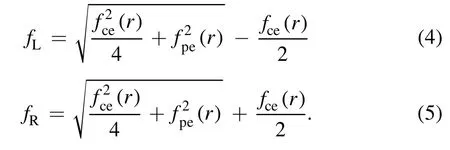
In the EAST experiments, the upper cut-off frequency is regularly used during the density profile inversion process because the lower one is rarely observed by reflectometry in EAST’s typical operational regimes.In high magnetic field and/or density discharges, the lower cut-off frequency is detected in the delay-time spectrum.The appearance of the lower cut-off frequency can be estimated using equation (4).
Figure 1 shows the density coverage ability for the lower and upper cut-off, respectively, under different magnetic fields.The so-called zero electron density ne0occurs when the probing frequency equals fce, as indicated by the black slash.The probing frequency is below fceon the left side,where the microwave is reflected at the lower cut-off layer.In contrast,on the right side, when f >fce, the microwave is reflected at the upper cut-off layer.It is clear that with the increasing magnetic field and plasma density,the range of the upper cutoff frequency becomes narrower.Furthermore, the influence of the second harmonic of the electron cyclotron frequency(f2ce)needs to be taken into account when fRand/or fLexceed the f2ceat the plasma boundary (ne=0).As shown by the white slashed line in figure 1, at the relatively low magnetic field (Bt<1.8 T), the location of f2cemoves toward the low probing frequency,which will significantly limit the coverage of the probing frequency in the X-mode upper cut-off reflectometry as the probing beam could be absorbed at fprob=f2ce.With the increase in the magnetic field, the range of detection frequency affected by f2cegradually decreases.Typically, the pedestal density covers a range up to 3.5×1019m-3[23] and the density coverage is up to~7.0×1019m-3at fprob=fR=110 GHz.In the experimental measurement,the raw signal in the probing frequency beyond 95 GHz becomes rather weak and is close to the noise level due to the influence of f2ce.Thus, the typical accessible density by the upper cut-off frequency is around 5×1019m-3.However, when the plasma parameters meet the requirements, the lower cut-off frequency can be observed in the probing frequency range of 33-50 GHz, which can be identified at fprob<fce.With the supplementary lower cut-off frequency, the X-mode reflectometry on EAST can potentially extend its radial coverage of high-density operations,e.g.the high-density H-mode or fueling experiments [24].

Figure 1.The measurable density range by the corresponding lower and upper cut-off frequencies under different magnetic fields.The frequency bands of EAST reflectometry are indicated by the vertical dashed line.The contour lines indicate the equal ne level that can be measured by the reflectometry on EAST.
The group delay time (τg) is calculated using τg=fbeat/(dfprob/dt), where fbeatis the beat frequency and dfprob/dt is the sweeping rate of the probing wave frequency.The phase delay associated with the detected frequency, as derived from the group delay spectrum, is used for the determination of microwave reflectometry electron density profiles[15,25].Figure 2 compares the time-delay spectra of the X-mode reflectometry measurements at different magnetic fields and plasma densities.The probing starts of the upper cut-off frequency are indicated by the vertical line.As shown in figures 2(a)and(c),the higher magnetic field(Bt=2.3 T)requires higher probing frequency at zero density, which is consistent with the results in figure 1.Furthermore,the lower cut-off frequency is visible in the Q-band (33-50 GHz)spectrum in figures 2(a), (b) and (d) in high plasma electron density cases.With the increase in the magnetic field and/or the plasma density,the lower cut-off reflection region extends gradually.
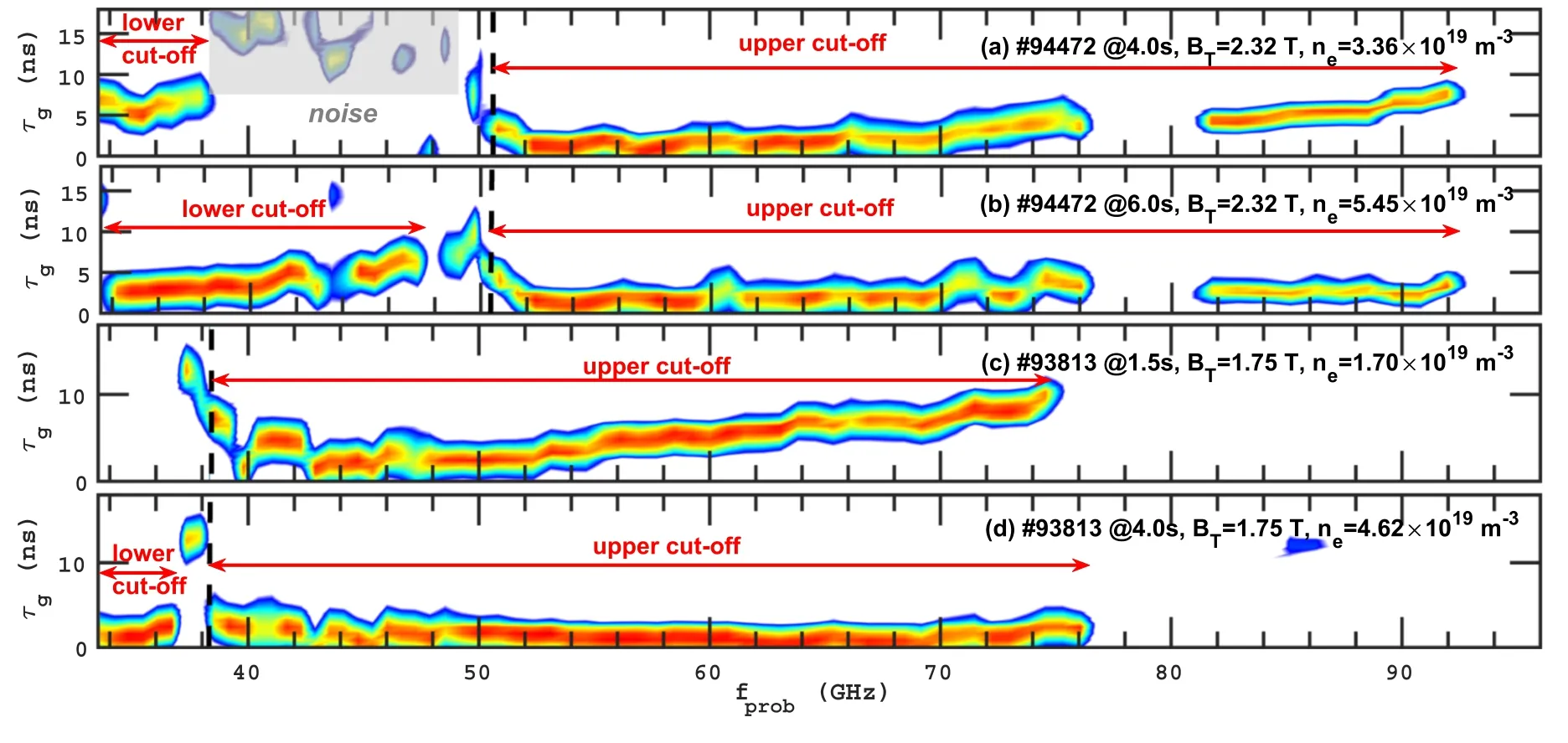
Figure 2.Time-delay spectra obtained from the X-mode reflectometry measurements on EAST with different magnetic fields and plasma densities.The frequency windows with reflection at the lower cut-off(left)and the upper cut-off(right)are marked,respectively.The empty region at fprob ~80 GHz is caused by the overlapped wave-mixing process in the optical combiner [26].
3.Experimental measurements of density profile
Figure 3 shows the delay-time spectra of the reflectometry signals at 5.62 s in a typical L-mode EAST discharge (#90330, BT=2.47 T) and at 4.9622 s in a typical H-mode EAST discharge (#88004,BT=2.32 T).The line-integrated density is measured by the 11-channel POlarimeter-INTerferometer (POINT) [27]; the values at the center chord are ne,line≈4.23×1019m-3and 4.64×1019m-3, respectively.As shown in figure 3, the lower cut-off reflection emerges at the incident frequency below 50 GHz, and the appearance is attributed to the high plasma density, regardless of the L-mode or H-mode regime.The transition between the lower and upper cut-off frequencies occurs at 53 GHz and 51 GHz.Note that τg≈13-14 ns at the probing frequency ranging from 41 GHz to 53 GHz in the discharge #90330 is caused by the back wall reflection.The corresponding τgof both upper and lower cut-off frequencies can be distinguished in the frequency range beyond and below the fce, respectively,which is indicated by the vertical dashed line in figure 3.
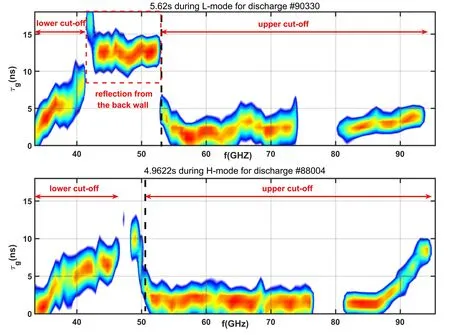
Figure 3.Delay-time spectra of reflectometry measurement in L-mode of discharge #90330 (above) and H-mode of discharge #88004(below).The transitions between the upper and lower cut-off frequencies are at 53 GHz and 51 GHz, respectively, during L- and H-mode,where the zero-density layer locates.
Figure 4 shows the group delays measured by the lower cut-off frequency (red dotted lines) and the equivalent group delay via the upper one (black solid lines).By assuming the density profile of the upper cut-off frequency, its equivalent group delay of the lower cut-off frequency can be simultaneously deduced (the black solid lines in figure 4).This equivalent τg,loweris then compared with the experimental measurement(the red line in figure 4).The confidence interval of the group delay is estimated to be the 1/e bandwidth of τgin figure 3.It would make sense if the τg,lowerwas overlapped or continued with the equivalent τg,upperthat is calculated using the upper cut-off frequency.Thus, the group delays of the upper and lower cut-off frequencies can be combined to reveal the overall density profile.In the reflection signal of the upper cut-off frequency,only a fraction of signals is reasonable in the probing frequency below 95 GHz, which restricts the measurable density profile in the plasma edge region.It is clearly seen that in both L-mode (figure 4 left) and H-mode (figure 4 right),a continuous τgis obtained in the overlapped frequency range of 35-48 GHz,yielding validation of the density profile inversion using the overall τg.It is also worth noting that the frequency coverage of the lower cut-off is much higher than the equivalent group delay that is obtained from the upper cutoff, which indicates that the density coverage can be further extended by supplementing the upper cut-off frequency with the lower cut-off frequency.
The overall neprofiles in the H- and L-modes obtained by the X-mode lower (red solid and dotted line) and upper(black and blue dots) cut-off frequencies are compared and depicted in figure 5.The error bars are calculated from the delay-time spectra in figure 3 and are mainly contributed by the bandwidth of the delay-time spectra.The method used for error calculation of the density profiles is taken from[20].The consistent evolution of two density profiles with the line-integrated densities yields a reliable validation of the lower cut-off reflection in the measurement of density profiles.In the weak signal level of τg,upperin the highdensity region, e.g.in the plasma core region, the profile resolution can be significantly improved by utilizing the τg,lowerindirectly.Density profiles during L-mode measured by reflectometry are further compared with the inversed profile of POINT.As shown by the green line in figure 5,the inversed density profile in the L-mode is overlapped for a benchmark.The agreement of the neprofiles from POINT and the reflectometry measurements, especially at the core region, implies that the lower cut-off frequency is capable of supplementing the density profile measurement via reflectometry.
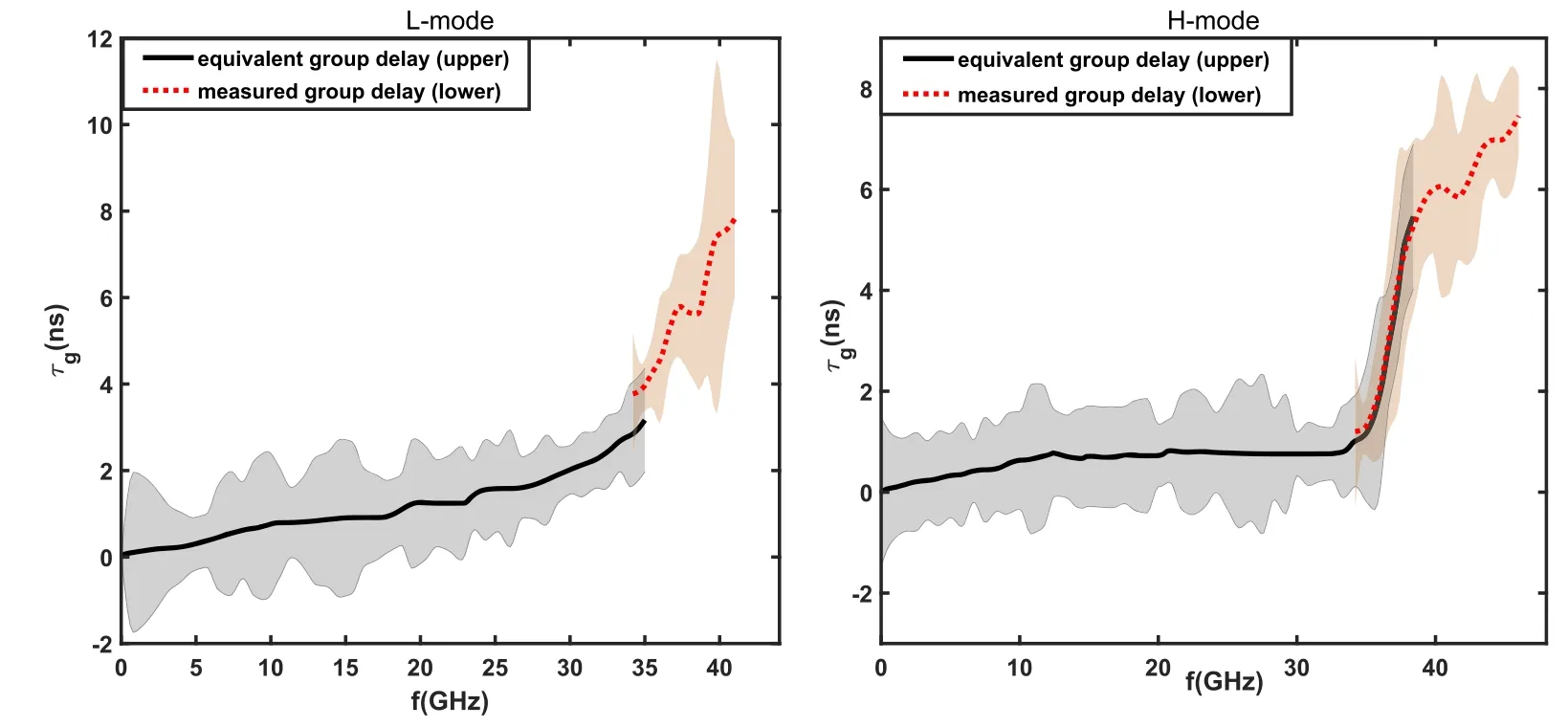
Figure 4.Group delays measured by the lower cut-off frequency (red dotted lines) and the equivalent group delay via the upper cut-off frequency (black solid lines) in L- (left) and H-mode (right), respectively.
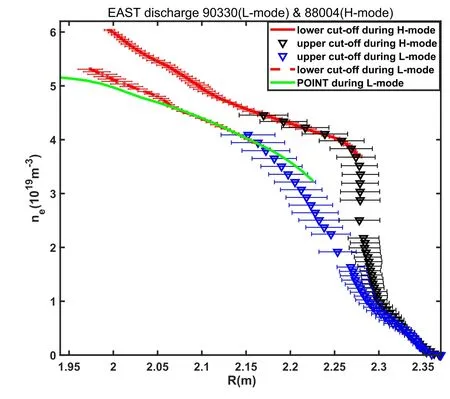
Figure 5.Density profiles obtained by the upper (black and blue triangles) and lower (red lines) cut-off frequencies in H-mode and L-mode.The green line is the ne profile of the POINT measurement.
4.Summary
To summarize our work, the density profile inversion process,using both the lower and upper cut-off frequencies, enables radial coverage expansion of reflectometry measurement with the emergence of the lower cut-off frequency.On the EAST tokamak, the lower and upper cut-off reflections have been simultaneously obtained in the X-mode polarized multi-band reflectometry diagnostic in high-density experiments, e.g.the H-mode and/or fueling discharges.The feasibility of the density profile measurements shown in this paper indicates that the application of the lower cut-off frequency is successfully accessible for the density profile inversion process and the radial coverage expansion.This experimental validation of density profile inversion by the lower cut-off frequency is of great importance for the measurement accessibility when developing the high-field side reflectometry system in ITER.Although the fprob,lowerrange is limited by the system bandwidth, the use of both lower and upper cut-off frequencies in the density profile inversion process can significantly extend the radial coverage of the reflectometry measurement, which provides a reference for the ITER reflectometry system in the radial coverage of the density profile in the high-density discharge.
Acknowledgments
The authors wish to acknowledge Dr.S.X.Wang for helping to analyze the POINT data.This work has been supported by the National Key R&D Program of China(Nos.2017YFE0301205 and 2019YFE03040002), National Natural Science Foundation of China (Nos.11875289,11975271, 11805136, 12075284, and 12175277) and China Postdoctoral Science Foundation (No.2021M703256).
ORCID iDs
 Plasma Science and Technology2022年5期
Plasma Science and Technology2022年5期
- Plasma Science and Technology的其它文章
- Integrated data analysis on the electron temperature profile of HL-2A with the Bayesian probability inference method
- Prompt acceleration of a μ+ beam in a toroidal wakefield driven by a shaped steeprising-front Laguerre-Gaussian laser pulse
- The influence of weak transverse magnetic field on plasma dissipation process in the post-arc phase in a vacuum interrupter
- Numerical study of the effect of coflow argon jet on a laminar argon thermal plasma jet
- On the green aurora emission of Ar atmospheric pressure plasma
- Dynamic characteristics of multi-arc thermal plasma in four types of electrode configurations
